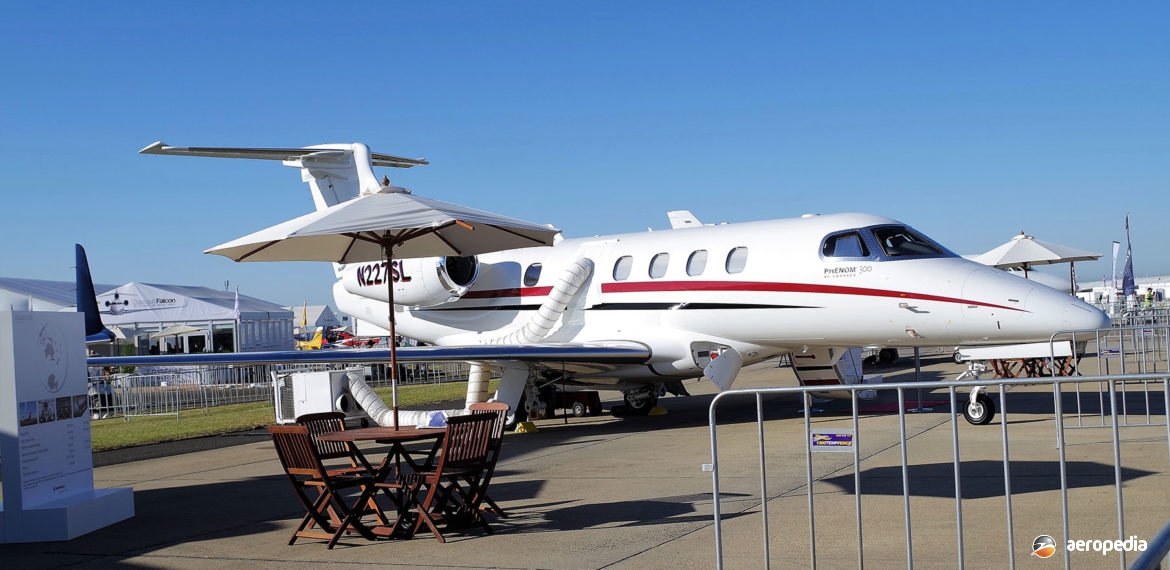Photograph:
Embraer Phenom 300 N227SL (c/n 50500395) on display at the Australian International Air Show at Avalon, VIC in February 2017 (David C Eyre)
Country of origin:
Brazil
Description:
Business & executive jet
Power Plant:
Two 3,360 lbst Pratt & Whitney Canada PW535E turbofans
Specifications:
- Wingspan: 16.2 m (53 ft 2 in)
- Length: 15.9 m (52 ft 2 in)
- Height: 5 m (16 ft 5 in)
- strong>Max cruising speed: 834 km/h (518 mph)
- Service ceiling: 13,716 m (45,000 ft)
- Max operating altitude: 13,716 m (45,000 ft)
- Take-off field length: 1,128 m (3,700 ft)
- Range with six persons on board and IFR reserve: 3,334 km (2,072 miles)
- Fuel capacity: 2,428 kg (5,353 lb)
- Loaded weight: 8,150 kg (17,968 lb)
History:
The Phenom 300 was developed by Embraer in Brazil with the advice of executives, pilots and owner/operators to meet the evolving needs of business travellers. It had a ‘new Oval Lite profile’ with an interior designed by BMW Group Designworks in California, USA to give a new level of comfort to a business trip. At 12,497 m (41,000 ft) it was pressurised to a cabin altitude of 1,829 m (6,000 ft). It could carry up to nine occupants, had a private toilet, refreshment centre and baggage area. It had an all-glass Garmin Prodigy flight deck, hot-air anti-ice systems for the wings and horizontal tail, full automatic pressurisation and a brake-by-wire system with anti-skid capability. It had single-point refuelling.
The prototype Embraer EMB 505 Phenom 300 (PP-XVI) flew for the first time on 29 April 2008 and was followed by the second (PP-XVJ), the third pre-series aircraft (PP-XVK) and the fourth (PP-XVL), all being used in the flight test program. The fifth (PP-XVM) joined the program in August 2008 and this aircraft was the first to be fitted with a complete interior.
The type entered operational service on 29 December 2008 with Executive Flight Services at Sao Jose dos Campos, Brazil and by that time 45 Phenom 300s had been delivered and had accumulated 1,000 hours.
Embraer began the design program for a new light jet aircraft aimed at allowing operations to smaller airports such as London City in May 2005. It was a twin-engine cantilever monoplane with low-positioned swept wings powered by rear pylon-mounted Pratt & Whitney Canada PW535E turbofan engines but did not have thrust reversers. It had a structural life of 28,000 flight cycles or 35,000 hours. It was constructed of 18 per cent composite materials. Access was via an airstair on the left-hand side at the front.
By late 2016 more than 350 examples had been delivered and the type was the best-selling light business jet in the years 2013, 2014 and 2015. The type hasoperated in 28 countries and has accumulated 300,000 flight hours. In July 2016 assembly of the type was moved to Melbourne in Florida, USA.
The first example of the type to operate in Australia was N217CB (c/n 50500305), delivered to the Lucas family in Warrnambool, VIC on 18 January 2017, being registered to Warrnambool Bus & Motor Company, later becoming N227SL. This aircraft was purchased to help support the company’s business, which involved operations across four States and involved transport, agriculture and hospitality sectors.
On 15 June 2017 an example became VH-NJC (c/n 50500080) registered to Power Capital Holdings Pty Ltd of Henley Brook, WA, this aircraft being operated by Revesco Aviation Pty Ltd based at Perth Airport.
On 21 June 2018 another example became VH-NSQ (c/n 5050043) to Finico Pty Ltd of Hamilton, QLD, being operated by Avcair.

